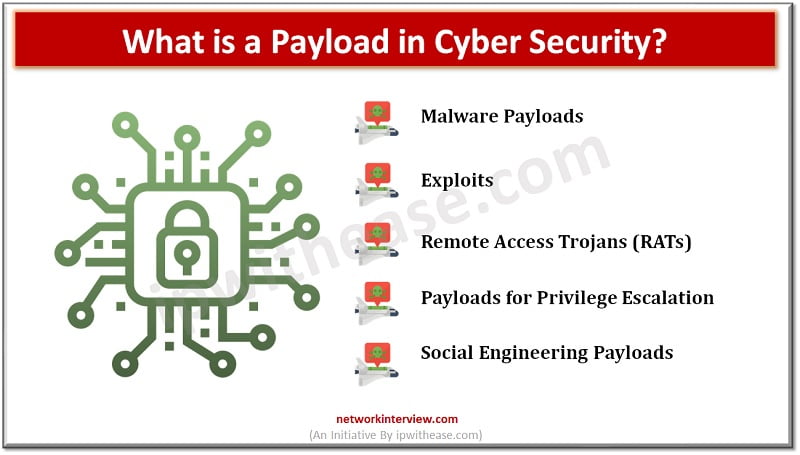
What is a Payload in Cyber Security? A Comprehensive Guide
As a cybersecurity professional, you will come across many technical terms and jargon in the field. One of the terms that we often hear in cybersecurity is “payload.” In simple terms, a payload refers to the part of a malicious program or exploit that carries out a specific action or delivers the intended malicious effect.
In this blog, we will explain what is a payload in cyber security, the types of payloads, common examples of payloads in cyber attacks, and payloads in ethical hacking.
What is a Payload in Cyber Security?
A payload in cybersecurity is a code that is designed to perform malicious activities on a victim’s computer or network. It is the part of a malware that is responsible for carrying out the attack. Payloads can be delivered through various means, including email attachments, infected websites, and even through physical means like USB drives.
Payloads can be designed to perform different types of attacks, including stealing sensitive information, taking control of a victim’s computer, or disrupting the normal functioning of a network. Payloads can be delivered as part of different types of malware, including viruses, Trojans, and ransomware.
Types of Payload in Cyber Security
Payloads can be classified into different types based on their behavior and the type of attack they are designed to perform. Here are some common types of payloads in cybersecurity:
Malware Payloads
Malware refers to malicious software, and its payloads are designed to perform harmful activities on the target system. Examples include:
- Viruses: Malicious code that can replicate and attach itself to other files or programs.
- Trojans: Programs that appear legitimate but contain malicious payloads, often allowing unauthorized access to the system.
- Ransomware: Encrypts files on the target system and demands a ransom to restore access.
- Spyware: Collects sensitive information, such as keystrokes, passwords, or browsing habits, without the user’s knowledge.
Exploits
Exploits leverage vulnerabilities in software or systems to gain unauthorized access or control. These payloads take advantage of weaknesses in the target system’s security defenses. Common exploit payloads include:
- Remote Code Execution (RCE): Allows an attacker to execute arbitrary code on a remote system, potentially gaining control over it.
- Denial-of-Service (DoS) or Distributed Denial-of-Service (DDoS): Overwhelms a system or network with excessive traffic, causing it to become inaccessible.
- SQL Injection: Exploits vulnerabilities in web applications to manipulate databases or execute malicious SQL queries.
Remote Access Trojans (RATs)
RATs provide unauthorized remote access to a compromised system. Attackers can control the infected system remotely and perform various malicious activities. RAT payloads often include features like keylogging, screen capture, file transfer, and webcam hijacking.
Payloads for Privilege Escalation
These payloads are used to elevate the privileges of an attacker on a compromised system. By exploiting vulnerabilities or misconfigurations, attackers gain higher-level access to the system, enabling them to bypass security controls or gain administrative privileges.
Social Engineering Payloads
Social engineering attacks aim to manipulate individuals into taking certain actions that may compromise their security. Payloads in social engineering attacks can be various forms of malicious content, such as phishing emails, malicious links, or attachments that trick users into revealing sensitive information, installing malware, or performing unintended actions.
Common Examples of Payload in Cyber Attacks
Here are some common examples of payloads used in cyber attacks:
Emotet Trojan
The Emotet Trojan is a banking Trojan that is often delivered through phishing emails. The payload is designed to steal sensitive information like usernames, passwords, and banking credentials. Once the payload is executed, it creates a backdoor on the victim’s system, allowing the attacker to access the system remotely.
WannaCry Ransomware
The WannaCry ransomware was one of the most devastating cyber attacks in history. The payload was delivered through a vulnerability in the Windows operating system and encrypted the victim’s files, demanding a ransom payment in exchange for the decryption key. The WannaCry attack affected over 200,000 computers in 150 countries.
Mirai Botnet
The Mirai Botnet was a massive botnet that was used in a DDoS attack against the DNS provider Dyn in 2016. The payload was delivered through infected IoT devices like routers and cameras, which were used to launch a massive DDoS attack against Dyn’s servers, causing widespread disruption to the internet.
Payloads in Ethical Hacking
Ethical hacking is the practice of testing a system or network for vulnerabilities and security weaknesses. Payloads are often used in ethical hacking to demonstrate the impact of a vulnerability or weakness. Here are some examples of commonly used payloads in ethical hacking:
Metasploit Framework
The Metasploit Framework is a popular tool used by ethical hackers to test systems and networks for vulnerabilities. The framework includes a wide range of payloads that can be used to demonstrate the impact of a vulnerability or weakness.
SQL Injection Payloads
SQL injection payloads are often used in ethical hacking to demonstrate the impact of a SQL injection vulnerability. The payloads can be used to extract sensitive information from a database or even take control of a victim’s system.
Conclusion
Payloads are an essential part of modern cyber attacks, and understanding them is crucial for anyone working in cybersecurity. By understanding payloads, we can better protect ourselves and our organizations from cyber threats.
Continue Reading:
How to make a career in Cybersecurity or Ethical hacking?
Top 10 Cyber Security Monitoring Tools
Tag:Security



